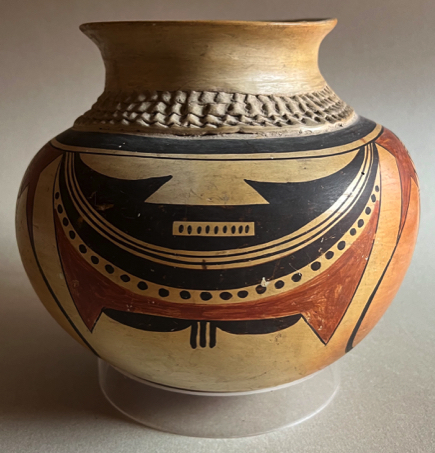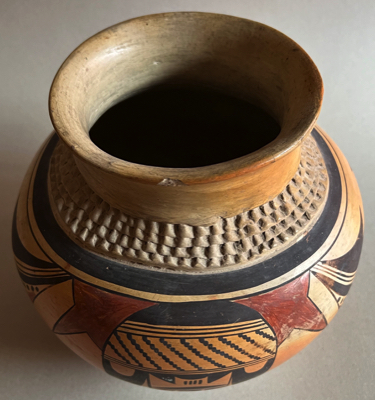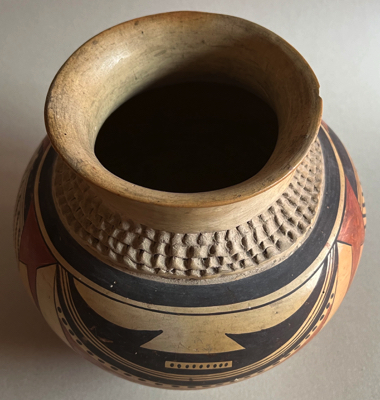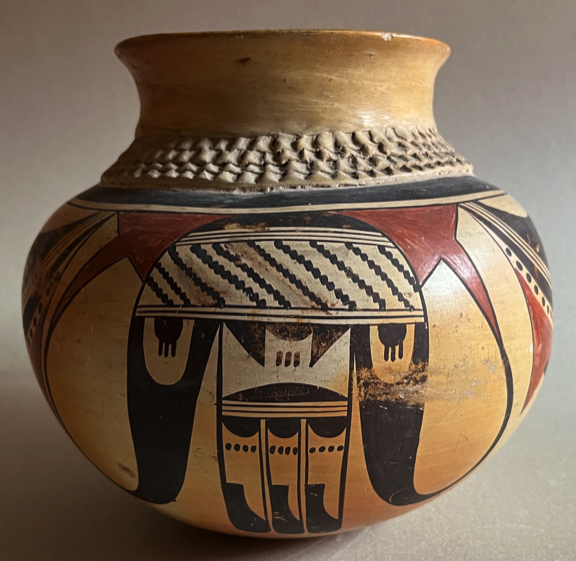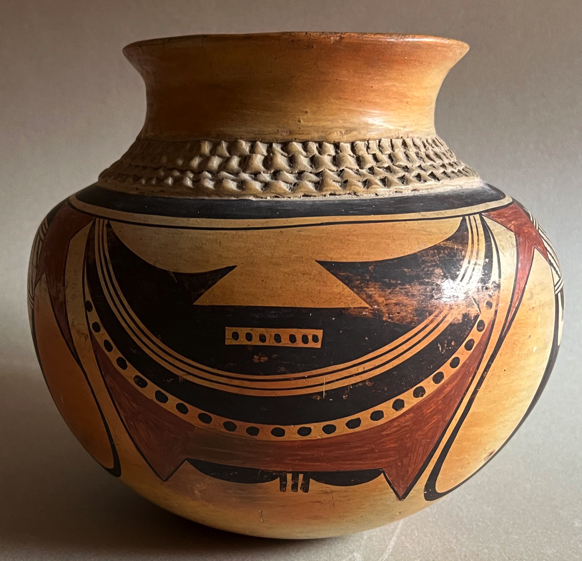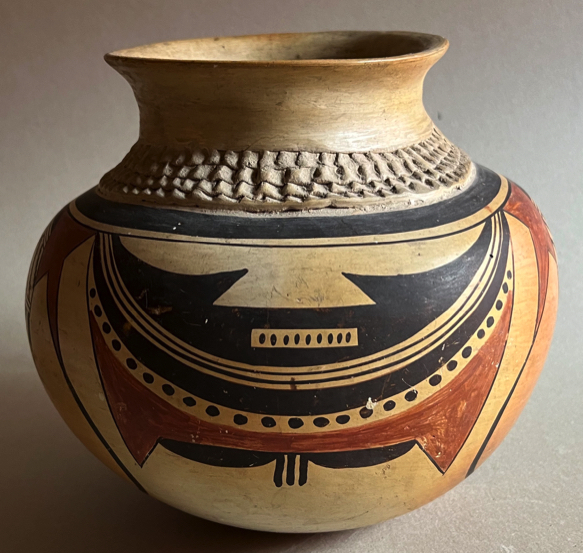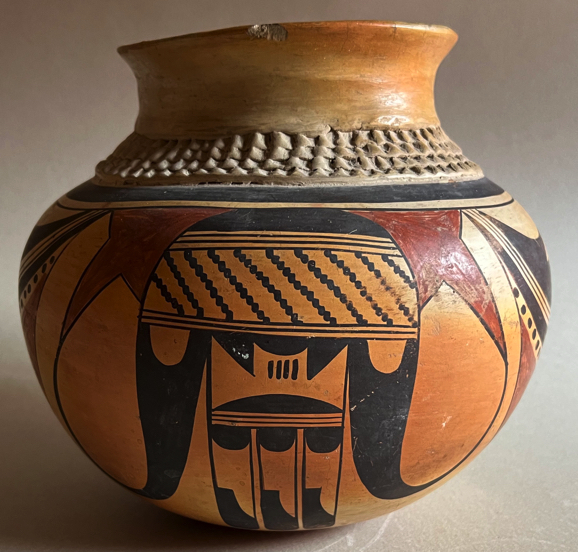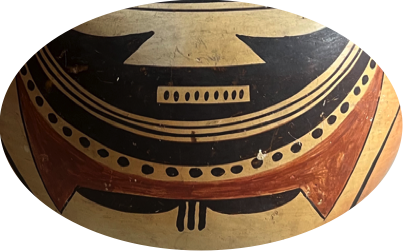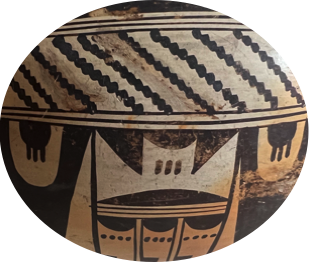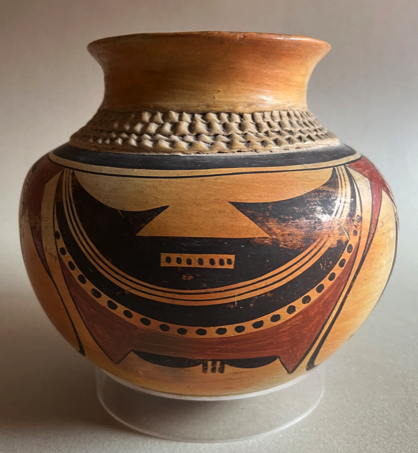© 2010-2023 by Fine Arts of the Southwest, Inc. All rights reserved.
Unauthorized reproduction or use is strictly prohibited by law.
An outstanding historic Hopi polychrome
pottery jar with a corrugated design panel
by Nampeyo of Hano, c.1905-1910
ONCE AGAIN WITH THE INCOMPARABLE HOPI POTTERY MATRIARCH, NAMPEYO (1859-1942), we have a master class
in Modern art being taught to us by someone who never once in her entire life set foot in an art studio or a school.
Nampeyo created her extraordinary art masterpieces under the sort of primitive circumstances that would make most modern day artists cringe and run for the hills in fear and while doing so, she set a standard of quality, beauty and innovation which has never been equalled. That she could conceive of and execute such extraordinary artworks sitting
on the dirt under the broiling high desert sun and the howling wind and the blowing dust boggles the imagination yet
here is the evidence and it is quite convincing evidence to say the least.
And what an extraordinary piece this is; possessed of a beautiful organic, globular shape and a freshness and a
powerful and exuberant expression of design that literally and figuratively takes one’s breath away. From what deep well does such inspired and awesome artistry spring up from? Nampeyo’s long and distinguished cultural heritage and history as a member of a prominent pottery-making family on the Hopi mesas and no doubt her own inimitable re-interpretation and presentation of the centuries-old ancient designs of her Hopi Sikyatki pottery and ancient Tewa Indian heritage and something else indefinable that always separates the greats from the not so greats; the hand of the divine possibly. Whatever the reasons, we are far the better for having a work of art such as this one in our midst and presence.
This jar has virtually all of the characteristics associated with Nampeyo’s fine work beginning with its beautiful
shape and finely formed vessel walls. The stone polishing is superb and the firing in difficult to work with extremely high-temperature lignite coal is flawlessly done yielding gorgeous “blushes” of various shades and gradations of
white and yellow across the vessel’s surface. But, it is the painted design which truly steals the show here; a complex four-part layout which literally explodes across the entire vessel’s surface. The design field is done in complete four-part bilateral symmetry meaning that the two opposite designs on either side of the jar are matching pairs.
This is a spatial arrangement which Nampeyo employed quite often in her work. The two pairs of designs are quite
different from each other, but work together in perfect harmony.
The pendant feather design is a motif adapted and stylized from ancient Sikyatki pottery (1375-1625 A.D.) and it is made all the more beautiful by Nampeyo’s graceful painted arabesques shifting subtly but completely intentionally in color from black into red. The artistic skill and imagination and the extreme technical and physical control required to execute such a design using a yucca fiber brush and hand-ground earth and plant pigments is almost impossible to contemplate. On the other two sides of the jar are designs reminiscent of stylized Hopi kachina masks or headdresses with Nampeyo’s often used stylized “clown face” or “Kilroy” motif at the bottom, seen here at upper right and at the top seen here at upper left, very interestingly executed in a positive/negative design in which the artistry of the unpainted spaces is just
a significant as that of the painted ones. The jar’s designs are made all the more remarkable for their stark, almost shocking modernity and especially so given the fact that they are derived from centuries-old ancient Hopi pottery motifs re-interpreted and re-presented in a stylized manner in a unique and highly personal manner all Nampeyo’s own.
“This superb jar is a masterpiece of proportion and design,
fully representative of Nampeyo’s finest work.”
-Hopi pottery scholar and author, Edwin L. Wade, Ph.D.
As the final and crowning decorative touch, Nampeyo applied several encircling bands of corrugation around the neck of the jar. In actuality, while they are in their placement at the top of the jar the “crowning touch” as we mentioned, so to speak, these corrugated designs were, in fact, the very first “decorations” Nampeyo applied to the jar well before the jar was painted and they function beautifully to frame and set off the finished painted design field. The various dots and diagonal surfaces in the painted designs seem in ways to echo the variegated corrugated surface itself. We have seen a number of Nampeyo jars with corrugated surfaces including one pictured here below in which the corrugation was applied directly with her fingertips leaving distinctive fingerprints in the clay surface, but it appears that the corrugation on this particular jar was most likely made with an implement, possibly a stick of wood.
The jar measures a medium-sized 9” in height and it is also 9” in diameter. While not particualrly large, the jar is nonetheless monumental in presence. The jar is in generally excellent original condition, particularly for its 115-120 or so years of age. There are a few areas of abrasion and paint loss and some insignificant tiny slip cracks here and there. There are no cracks in the clay body, no significant chips, just a small 1/4” chip on the rim. On the interior bottom of the jar there is some slight evidence of exfoliation due possibly to the jar having held water at some time period. A thorough examination of the jar under ultraviolet light reveals no evidence at all of any restoration or over-painting.
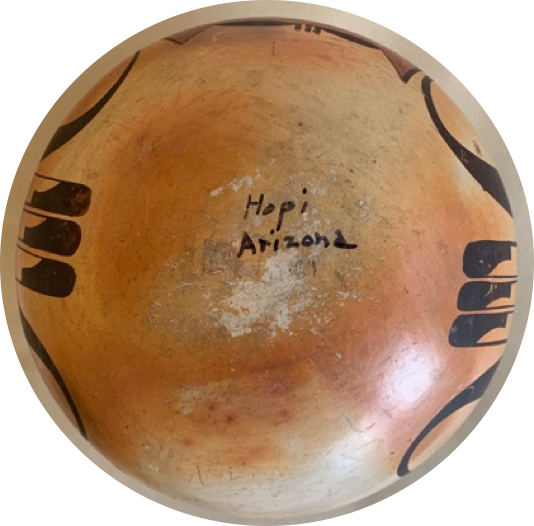
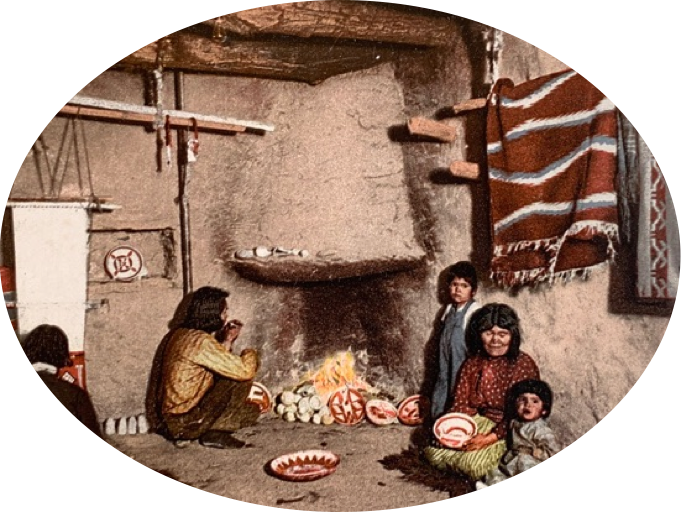
Nampeyo and her family are shown in their “summer residence” at Hopi House at the Grand Canyon in a 1906 Fred Harvey Company promotional post card.
There is an inscription handwritten on the jar’s bottom which reads “Hopi Arizona”. This inscription is fired into the jar
in what appears to be the same black paint used in the painted designs meaning that it is original to the piece. Nampeyo is known to not have spoken, read or written in the English language so this inscription was most likely put there by one of her elder pottery-making daughters and assistants, Annie Healing Nampeyo (1884-1968) or Nellie Nampeyo (1896-1978) or painted by Nampeyo herself copying an inscription shown to her by someone else.
The upper and lower case configuration of this written inscription resembles Annie Nampeyo's hand which we have seen on other examples of Annie’s and Nampeyo’s pottery which Annie is known to have signed for her on rare occasions. This inscription might indicate that this particular jar was made for exhibition and sale at The Fred Harvey Company’s famous Hopi House built in 1905 on the South Rim of the Grand Canyon where Nampeyo and her family resided over a couple of summers in the first decade of the 20th Century, demonstrating, making and selling their pottery.
Now it's time for the wind-up. At the end of the day, we have been very fortunate to have sold quite a few of Nampeyo’s most important pottery masterpieces over the years, including a sizable number which are now on display in the permanent collections of important museums such as The Art Institute of Chicago and Scottsdale, Arizona’s Museum
of the West. Many of these pieces have sold in the high to low six figures and many more in the mid-five figures. Some of these pieces have been larger, some smaller, some differently shaped and designed, but for pure all-out visual explosiveness, originality and dynamic energy, this 9” jar stands tall with the finest of any and all of them artistically and even more attractively it is exponentially less expensive than most. It is that rarest of the rare in the art world,
a unicorn for the price of a sheep, a diamond for the cost of a cubic zirconium, a six-course gourmet feast for the price of a fast food snack, so to speak.
SOLD
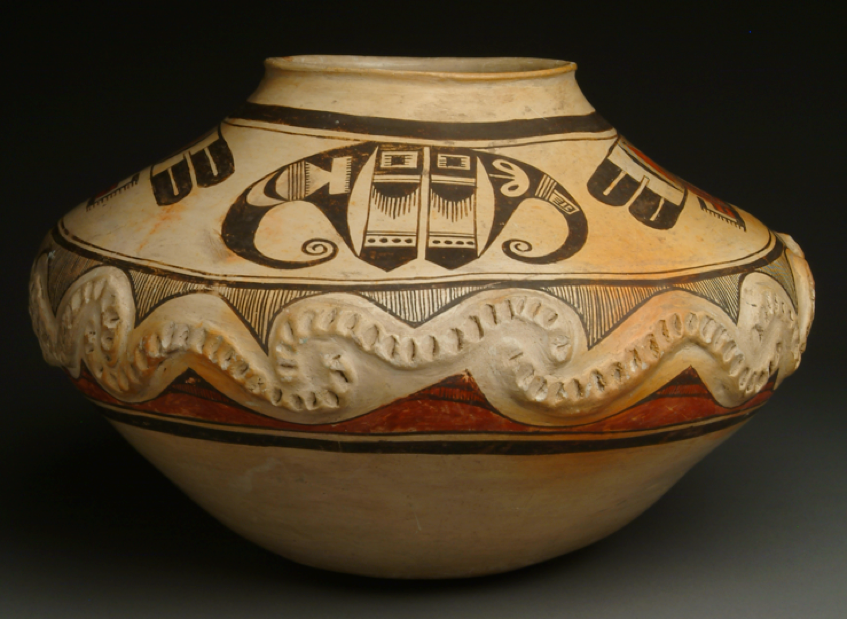
A large Nampeyo pottery jar with a band of corrugated design, c. 1905. This jar was sold by us in 2002 and is now in the permanent collection of The Scottsdale Museum of the West, Scottsdale, Arizona.
Photo source and © Fine Arts of the Southwest, Inc., Santa Fe, NM. Photo by Addison Doty.

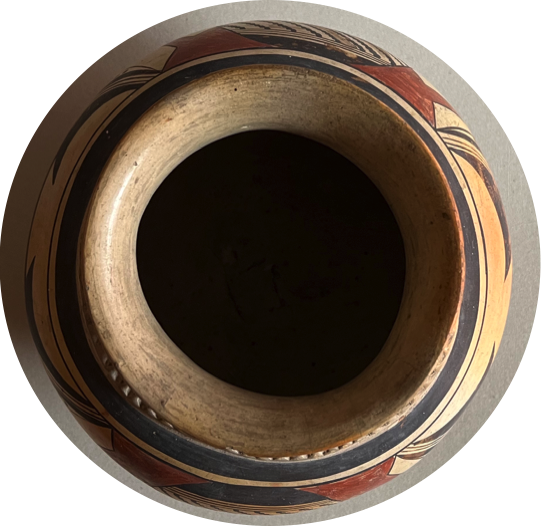
The jar also has a slight amount of “lean” as it sits on a table when seen from certain angles but, this is completely normal for an entirely handmade, older-style, round-bottomed jar which were originally and historically meant to sit on a sand floor in a room in a Pueblo home. In our view, this slight asymmetry only adds to the handcrafted authentic human nature of the piece, but if this bothers you in any way, the jar can always be placed atop a clear plexiglass pottery base as shown here which would allow it to be displayed in a straighter fashion and still allow you to view the round bottom. There is also a small area of slightly shadowy or ghostly diagonal painted designs where it appears that Nampeyo herself changed her mind about the particular placement and spacing of some of the diagonals and adjusted them accordingly. We have seen this sort of design adjustment made in mid-stream on numerous of Nampeyo's other pottery vessels over the years.
